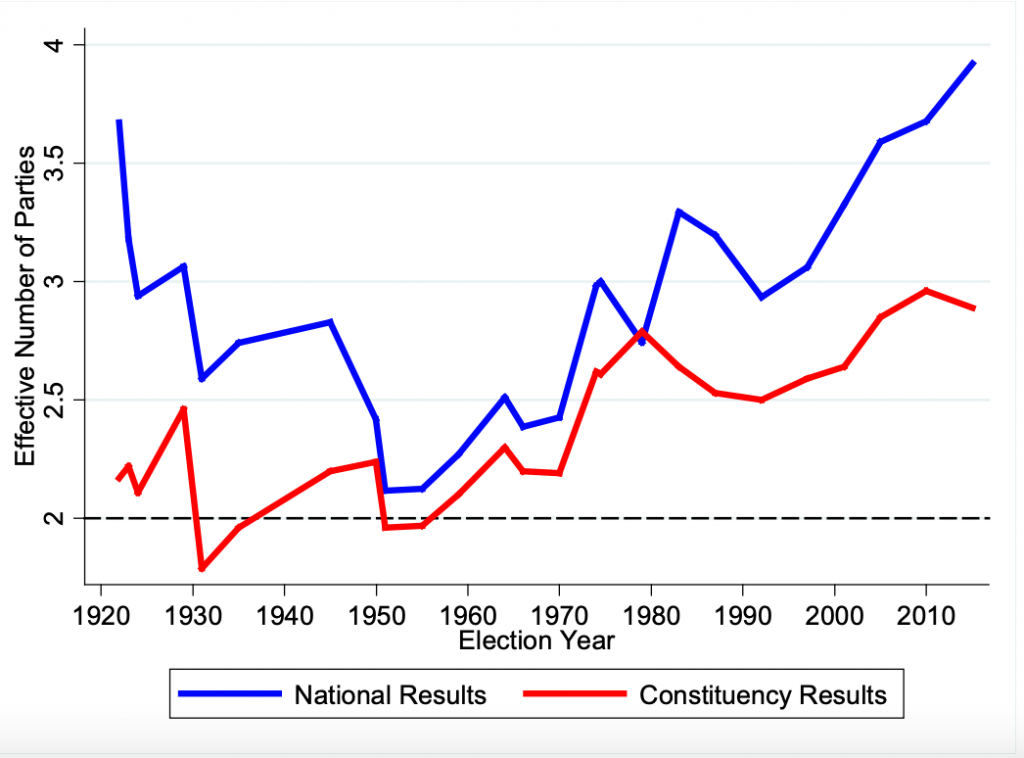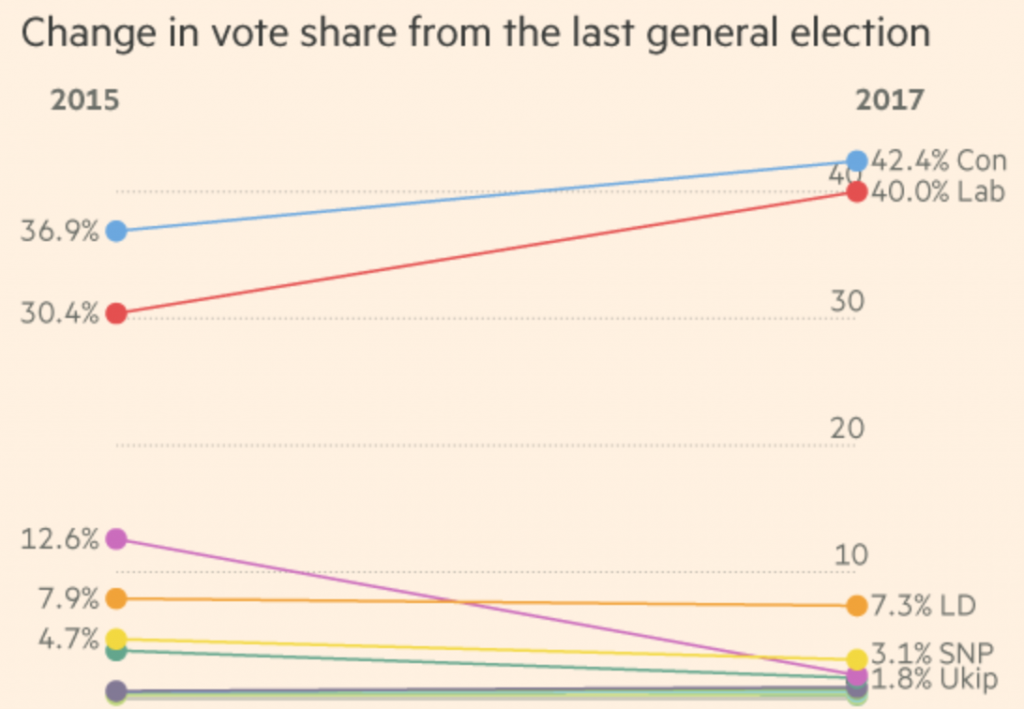Multipartisanship in Britain- Fact or Fiction?
From a technical perspective, Britain must be considered a multi-party system in the sense that contests are open to feature multiple parties within the apparatus. Elections since the 1970s have seen a huge rise in fragmentation compared to those at mid-century. A rise in minority parties is to blame for this, such as the Scottish National Party and the Liberal Democrats. Evidence of this lies with the fact that in the 1950s, Conservative and Labour made up 90% of the vote but the last election granted them a combined 76% of vote. (UK Parliament, 2020) Britain has exceeded two parties for a long time, which is evident in the effective number of parties competing at both national and constituency levels. (figure 1)

figure 1- Two Measures of Party System Fragmentation Over Time (Raymond, 2016)
CASE STUDY: 2010 CONSERVATIVE-LIBERAL DEMOCRAT COALITION AND BEYOND
A decline in support for Britain’s two traditional parties is common knowledge at this point. 2010 can be considered to be the breaking point of this. In this election year, a documented rise of 1.9 million votes were recorded for minor parties, giving them an overall 6.4% of the vote. (Clarke, 2012) This clear dissatisfaction with the dominant parties manifested itself in the form of a forced Conservative-Liberal Democrat government because both the Conservative and Labour parties failed to produce a winning majority. The very creation of this proves that Britain is a multiparty system rather than a two-party system because the government at this time was conducted by the largest and third largest parties. From the election of this coalition onwards, the British political sphere bore witness to a change in media representation regarding parties as mainstream news outlets like the BBC and ITV news actively took an interest in smaller parties, even televising several election debates that welcomed their ideas. (Guthrie, Pederson)
Since 2010, support for smaller parties has continued to skyrocket. Growing economic and social differences between voters and the ideologies of the Conservative and Labour parties has facilitated this to an unprecedented extent. (figure 2) The ascension of the Scottish National Party to the third largest party in the House of Commons with 45MPs is a perfect example. Expanding support for an independent Scottish state along with the SNP’s remarkable ability to maintain strong connections with Scottish society has boosted voter percentage massively and has created a strong party. (Baldi, 2023) Furthermore, as of 2019, experts have revealed that a fundamental shift has occurred, making the UK a fundamentally multi-party democracy. (Hughes, 2019) Therefore, multipartisanship has never been clearer in Britain as voters opt to fragment votes across more parties based on ideology instead of remaining silent when the two dominant parties do not deliver.

figure 2- 2019 UK Election Results (BBC, 2019)
CONTINUED DOMINANCE OF TWO-PARTY POLITICS- WHY?
Despite increased trends of multipartisanship throughout Britain, ultimately the political sphere is still currently dominated by Conservatives and Labour. This is partly because of the limited room for expansion in the UK’s simple plurality election system, that insulates the dominant parties from ever-improving performances of smaller parties. (Lynch, 2007) However, this can more recently be attributed to Brexit and the resulting fallout. The 2017 election saw the disruption of a long running narrative towards a multi-party system in the UK as the EU referendum resulted in shifts of support that hugely benefitted the dominant parties. This is because the limited choice on the Brexit deal- either ‘stay’ or ‘remain’ forced voters into a structure of more hardline voting than what they would typically demonstrate. This left no room for aspirations of smaller parties, as their ideologies were adopted by either Conservative or Labour in an effort to attract their voting base to one of the dominant two. (figure3) For example, the government began to adopt UKIP policies on immigration so that by the time the election rolled around more than half of UKIP voters already planned to vote Conservative. (Prosser, 2018) ‘Leave’ voters shifted from Liberal Democrats and Labour to Conservative, whilst ‘remain’ voters now fell under the umbrella of Labour. Therefore, it is evident that the two-party system will always prevail in difficult political circumstances as it is easier for voters to compartmentalise their thoughts in this way.

figure 3- 2015-2017 Election Result Comparison (Financial Times, 2017)
In conclusion, the British system is undeniably multipartisan, even if this is not reflected in election results. However, the two-party system has by no means been eradicated and remains a strong influence on the UK’s political sphere.
bibliography:
- Baldi, G (2023) ‘Politics Without Society: Explaining the Rise of the Scottish National Party.’ British Politics. 18(3) pg 342- 363.
- Clarke, A (2012) ‘Political Parties in the UK.’ Palgrave Macmillan. Houndmills, Basingstoke, Hampshire.
- Financial Times (2017) ‘Election Results 2017: Full List and Map- Voters Return a Hung Parliament’ UK General Election. Available at: https://ig.ft.com/election-results-2017/ accessed on: 27/2/24.
- Guthrie. Pederson. ‘The Rise of Single-Issue Parties in UK Politics: A New Direction in Representative Democracy?’ Politics and International Relations Dissertation.
- Hughes, D (2019) ‘Shock Westminster Polls Reflect ‘’Long Term Shift,’’ to Multi-Party Politics, Say Experts.’ Statement from the Electoral Reform Society. Available at: https://www.electoral-reform.org.uk/latest-news-and-research/media-centre/press-releases/shock-westminster-polls-reflect-long-term-shift-to-multi-party-politics-say-experts/ accessed on: 27/2/24.
- Lynch, P (2007) ‘Party System Change in Britain: Multi-Party Politics in a Multi-Level Polity.’ British Politics. 2(3) pg 323-346.
- Prosser, C (2018) ‘The Strange Death of Multi-Party Britain: The UK General Election of 2017.’ West European Politics. 41(5) pg 1226-1236.
- Raymond, C (2016) ‘Why British Politics is not a Two-Party System.’ Political Insight: Peer Reviewed Version. Queens University, Belfast.
- UK Parliament (2020) ‘General Election 2019: Full Results and Analysis.’ Available at: https://commonslibrary.parliament.uk/research-briefings/cbp-8749/ accessed on: 27/2/24.
Your blog gives a very good overview of the evolving party dynamics within the British political landscape, highlighting both positive trends and challenges.
I think your blog effectively illustrates the shift towards a multiparty system in Britain, emphasising the growing influence of minor parties and the decline of traditional two-party dominance. The case study of the 2010 Conservative-Liberal Democrat coalition succinctly demonstrates how smaller parties have become significant players in shaping government formations, signalling a fundamental change in British politics. Also, your discussion of the media’s evolving coverage of smaller parties highlights the increasing recognition and visibility they have gained in recent years, contributing to a more diverse and inclusive political discourse.
The only thing I think this blog would benefit from is, while you effectively note these challenges, deeper exploration of potential reforms or strategies to address them would enhance the analysis.
Overall, your analysis provides valuable insights into the complex dynamics of British politics, offering a nuanced perspective on the trajectory towards a multiparty system. Further exploration of potential solutions to overcome obstacles to multi-partisanship would enrich the discussion and offer a more comprehensive understanding of the evolving political landscape in Britain.